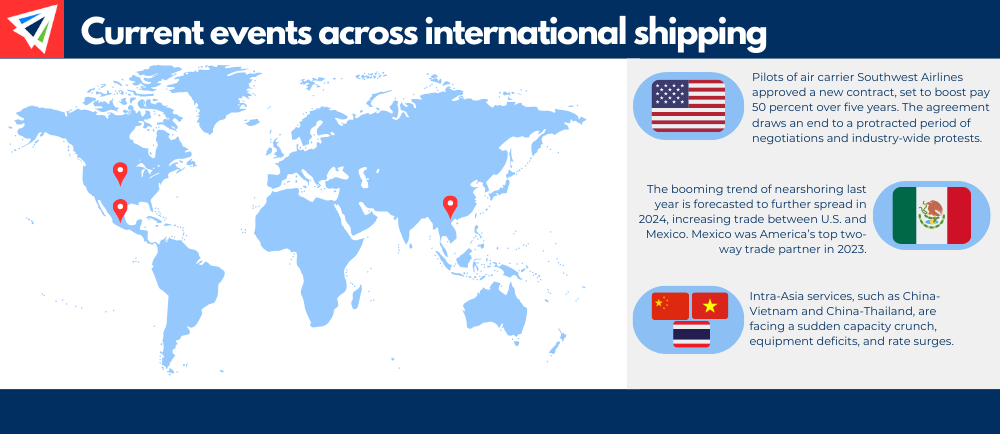
IMPORT: Asia to North America (TPEB)
Recent Developments:
- Major carriers implemented another round of general rate increases (GRIs) on January 15. These increases are in play for Asia services to all U.S. coasts.
- Surcharges remain imposed on transits through the drought-hit Panama Canal. Transit times continue to deteriorate.
- Carrier services remain transiting around Africa to avoid the Suez Canal. Transit times and rates have increased, while more capacity is being absorbed due to service requirements.
Rates: Rates have nearly doubled since late December. Longer transits (avoiding the Suez) will increase shipping demand measured in ton-miles (volume multiplied by distance), a factor further applying upward pressure on rates.
Space: Space has tightened amid external supply chain events.
Capacity: Longer transits averting the canals will absorb vessel capacity in order to maintain weekly services.
Equipment: There are no outstanding equipment deficits or bottlenecks.
TIPS:
- Chinese New Year begins Feb. 10 with related disruptions beginning days, if not a week, sooner. Establish a firm timeline for import activity as well as a vetted pool of multiple logistics providers. Do you need your freight out of China before the holiday or can you wait after?
- Hold your logistics partners accountable for frequent updates regarding current market conditions and routing impacts.
- Be flexible and adaptive to alternative service options, especially as it relates to potential savings on cost or transit.
IMPORT: Europe to North America (TAWB)
Recent Developments:
- Ocean carriers are implementing EU ETS surcharges onto trade lanes to and from E.U. countries to cover newfound costs from the program.
Rates: Rates have fallen since early January. This development signals that demand remains far too low for carriers to sustainably lift prices. Space: Space is open.
Capacity: Capacity remains in excess. Carriers are partially curbing this by reducing the size of vessels operating on transatlantic lanes. However, blank sailing activity remains minimal.
Equipment: Availability on both origin and destination sides, unless advised otherwise.
TIPS:
- Book at least three weeks prior to the ready date.
- Communicate with your logistics partners to ensure that you’re up to speed on the EU ETS program and its evolving impacts on transatlantic trade.
EXPORT: North America to Asia
Rates: Rates are low and level.
Capacity: Space remains open, particularly from West Coast ports, however carriers remain curbing capacity via blank sailings and slow steaming as U.S. import demand remains challenged.
Equipment: Barge services in China will be temporarily suspended in early February due to this year’s Chinese New Year holiday.
TIPS:
- Insufficient communication with sailing schedules can lead to higher detention and demurrage fees as well as higher trucking and storage costs. Ensure your logistics partners are not keeping you and your cargo in the dark.